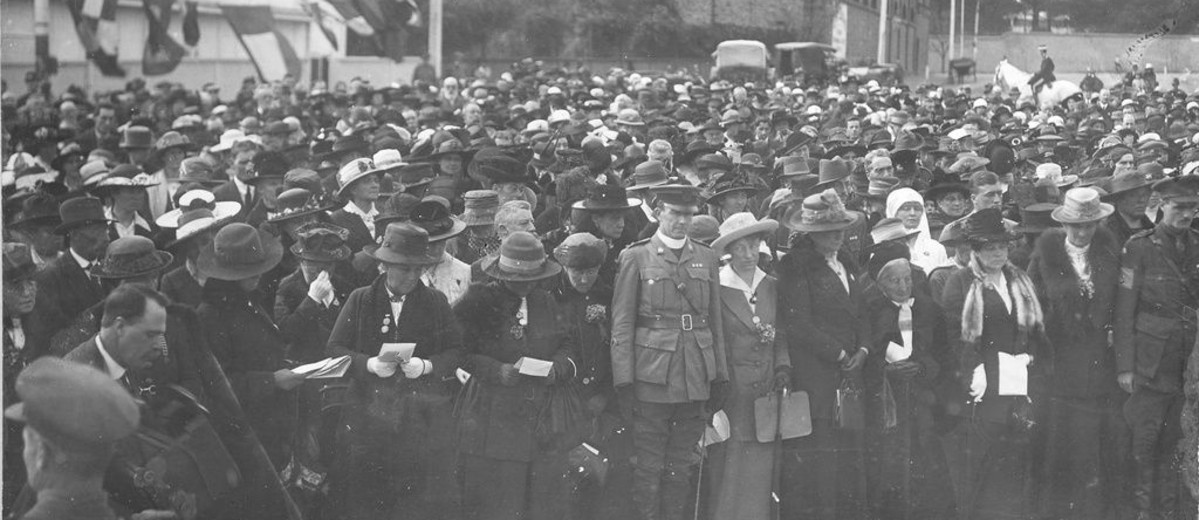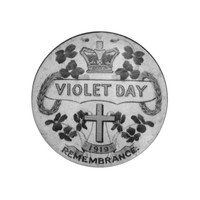Before the poppy became the recognised flower for remembrance, the violet in South Australia, was the 'symbol of perpetual remembrance'. Violet Day was first held in Adelaide on 2 July 1915. Alexandrine Seager, Secretary and Organiser of the Cheer-Up Society, is credited with the creation of the event.
Conception
The original idea appears to have been to remember the war dead, in reaction to events at Gallipoli in April that year, but the commemoration extended to honouring the wounded and all those who had made sacrifices for their country.
The Daily Herald in Adelaide reported in the lead up that:
...it is fitting that there should be some public sign of sorrow and honor. The fragrant violet will put us in mind of what Socrates described as "the perfume of heroic deeds." (The Daily Herald, 2 July 1915, 'Violet Day', p. 4)
The First Violet Day
In 1915 fresh violets were sold to raise money to support returned soldiers, or the Cheer-Up fund. Members of the Cheer-Up Society also sold ribbons with the words 'In Memoriam' to be worn with the violets, or violet posies tied with purple ribbon printed with 'In Memory' and the Christian cross. In all around 100 women dressed in white carried trays of violets to sell through the city of Adelaide, and raised over £700.00
People gathered at the South African War Memorial, known then as the 'Soldiers' Memorial Statue', for speeches and a performance by the Police Band. The Governor, Sir Henry Galway, addressed attendees, stressing remembrance and honouring of Australian troops and their sacrifice to Empire. He also told the crowd:
Today we not only honour the day, but our hearts go out with the deepest respect and sympathy to they who are mourning the loss of their nearest and dearest. The British Empire will never be able to repay the debt owed to the women for their calm self sacrifice in this great struggle. ... (The Advertiser, 3 July1915 p. 17 )
Janice Pavils describes the 'spontaneous demonstration of Violet Day as a form of grief management' with the 'memorial as a substitute communal headstone ...' (Pavils, Janice 'Anzac Culture' p. 54) The statue was draped in purple and white ribbons, and memorial wreaths were laid by attendees.
Development
From 1916 onwards badges, or 'commemorative buttons', were sold along with the fresh violets. The date of Violet Day changed frequently, the first few years ranging from mid June through to early August. From 1916-1917 the Adelaide Violet Day memorial service was held near Anzac Arch (a large archway erected near the Cheer-Up Hut to welcome returning ANZACs).
In 1917 and 1918 volumes of poetry were also sold to raise money. The emphasis at the Violet Day memorials, apart from honouring the dead, was on fundraising for practical support for soldiers, especially the wounded. While the day of commemoration was not always the same, Violet Day events were held across South Australia. In 1918 combined efforts saw South Australians raise over £4000. Funds went towards the work of the Cheer-Up Hut.
In the interwar years Violet Day continued to be observed in South Australia, with fundraising going towards activities such as the upkeep of the 'Soldiers' Cemetery' at West Terrace (The Advertiser, 1 August 1936, p. 16). In the early to mid 1920s a service took place at the Exhibition Building on North Terrace. Around this time the name in reports changes from 'Violet Day' to 'Violet Memory Day.' From 1924 onwards Violet Memory Day was observed on the first Sunday in August. In 1927 the service was shifted to the Adelaide Town Hall, where it remained for as long as the Violet Memory Day services continued. Proceedings generally included an organ recital, hymns, a school choral performance and religious readings. The focus shifted again to remembering the fallen. The Town Hall was decorated with violets and other floral tributes.
The annual service took on further significance with the outbreak of the Second World War, though the format continued in much the same way. After the service at the Town Hall violets were laid at the South African and National War Memorials, and at the Cross of Sacrifice in the Garden of Memory, West Terrace. Funds raised as part of Violet Memory Day commemorations continued to be donated towards the upkeep of the Australian Imperial Forces (AIF) graves in the West Terrace Cemetery. Following the Second World War the commemorations were extended to incorporate the fallen soldiers of both conflicts. The fiftieth anniversary of Violet Day saw hundreds of people gather in Adelaide.
Uniquely South Australian?
Violet Day has been referred to by some as a South Australian event. While it was certainly marked here in an enthusiastic manner, there are several accounts of similar activities interstate. In Melbourne The Argus reported on successful Violet Day sales in June of 1915, which raised money for the Australian Wounded Soldiers' Fund. Preparations for a Sydney Violet Day on Friday 20 August 1915 were announced in the Sydney Morning Herald. In later years Violet Days were held in New South Wales and Queensland. There was also at least one Violet Day held in New Zealand, in 1918.
Most Violet Day events outside of South Australia seem to have been early fundraisers where fresh violets were sold. The widespread activities in numerous country towns and annual sale of badges, or buttons, however does appear to have been a South Australian phenomenon. Broken Hill did hold an annual Violet Day for a number of years, the last large community event taking place in 1920. Through the 1920s-1940s Methodist churches in Broken Hill continued to hold a Violet Day service. This might be explained by the close ties between Broken Hill and Adelaide, with organisations such as the Red Cross connected to the Adelaide branch when established rather than Sydney administration. Violet Day continued to be marked in South Australia long after the practice appears to have disappeared from other states.
The Last Violet Day
Enthusiasm for continuing to hold Violet Day commemorations gradually waned. The last Violet Day in South Australia took place on 2 August 1970. The same section of the RSL's 1970 annual report which notes the event at the Adelaide Town Hall also records the success of the Field of Remembrance commemorations and fundraising, involving the sale of poppies around Rememberence Day in November, perhaps an indication of where interest had shifted. The Poppy Day Trust Fund received $787.53 that year, while no mention of fundraising is made in the Violet Memory Day summary. This instead focussed on the service address by the Rev. Keith Seaman and the Rev. John Hughes, organ recital by Mr Edward Gare MBE, and performance by the Adelaide Girls' High School Singing Group.
The following year the Violet Memory Day Committee met in May to vote unanimously to discontinue the Town Hall service, though they expressed some sadness at doing so. Remaining funds were paid to the AIF Cemetery Trust. Thus Violet Day appears to have faded quietly from the collective consciousness.
In 2015, with commemorations of the First World War in full swing a variety of community groups once again marked Violet Day, or drew on its history for public events and exhibitions. 100 years since the first Violet Day people in South Australia once again reflected on the symbolism of the humble violet.

Glad you found a connection Chris! It's intriguing what will jog the childhood memories. Many families must have once had collections of fundraising badges, or buttons as they were often called.
Came to this site in a very convoluted way .I have been tasked to provide a momento for a Remembrance Day event this year at my sporting club.I have just bought a 1919 Violet Day badge off Ebay and am contemplating enlarging the image onto a poster....early days yet but hopefully a uniquely South Australian flavour will added to the mix .However the surprise I got was reading of the connection to Broken Hill.My Grand Parents were from there but moved to Adelaide after ww2 .As a child I can remember my Grandfathers garden with Violets growing wild and the Violets holding something dear to my Grandparents.Had they had been involved as young people in the 20s I will never know however I feel there just may be some connection.Another childhood memory was a large collection of similar buttons pinned to a blind on the backdoor,memories of a 5 year old !!Thankyou very much for some interesting information Chris Q

That's really wonderful to hear Nicole, and the first time I've heard about a tin violet arch, I'd love to see it.
This Sunday 2/8/2015 Clarendon Uniting Church continues to celebrate Violet Sunday Laurel Jared has kept the tradition alive at Clarendon and makes sure we have violets on the Communion table. The church still has a tin Violet Arch in which the violets are placed. Not many people grow violets these days so can be trcky to source.

That's a very moving story Welwood, and some parallels with a story contributed by Christine on Adelaidia - http://adelaidia.sa.gov.au/favourite-flower
Established in 1900, Jones' Violet Farm at Third Creek Magill was run by my great grandparents, William and Margaretta Jones, who grew and supplied violets for Violet Day from 1915 until 1929. Charabangs drove loads of people from Adelaide to Magill to pick violets and take Devonshire tea at the farm. The last person born at the Violet Farm was my mother, Lydia Anderson, nee Jones, who passed away on July 1, 2010, aged 94yrs. Her Memorial Service saw violets covering her coffin in memory.

Thanks William, sounds like you have a fantastic collection there! We have some examples in the History SA collections of similar items, but not a comprehensive representation of all the badges made. We're in the process of digitising them and getting them up online, so maybe you can then compare what you have? I've seen Violet Day badges from 1916, 1917 & 1919, and many undated, but never one dated 1918. More research needed!
My grand mother left me over 100 buttons [badges] of various types including Violet Day, Wattle Day League, Red Cross ,Cheer-up Society and many others. The Violet Day buttons date to 1916, 1919 and one without a date, all the other buttons date around the same time. It is good to have this site to learn of the historical signifigance of these relics of a by-gone era.
The Advertiser, 3 July 1915, 'The War' p. 17
The Advertiser, 1 August 1936, 'Violet Day' p. 16
The Argus, 14 June 1915, 'Violet Day in Fitzroy', p. 13
Boarder Watch, 26 June 1915, 'War Notes: Violet Day', p. 2
The Daily Herald, 2 July 1915, 'Violet Day', p. 4
Leadbeater, Maureen, Adelaide Cooperative History, 'Violet Day: World War I South Australia', http://www.ach.familyhistorysa.info/ww1violetday.html accessed 8 October 2014
Pavils, Janice, ANZAC Day: The Undying Debt (Adelaide: Lythrum Press, 2007)
Pavils, Janice, 'ANZAC CULTURE: A South Australian Case study of Australian identity and commemoration of war dead' (PhD, The University of Adelaide, 2004) pp 53-56
Port Pirie Recorder and North Western Mail , 24 August 1916 'The Case for Violet Day' p. 1
The Mail, 28 July 1923, 'Violet Day' p. 1
The Register, 1 May 1915, 'General Items', p. 10
The Register, 30 June 1915, 'Violet Day', p. 8
The Register, 25 June 1917, 'Violet Day', p. 6
The Returned Sailors' Soldiers' and Airmen's Imperial League of Australia (RSL), South Australian Branch Inc. Annual Report various editions,1940-1971.
State Library of South Australia SRG 435, Returned Services League South Australian Branch Inc. papers, folder 'Minutes: Violet Memory Day Committee'
Sydney Morning Herald, 11 August 1915, 'Violet Day', p. 5
Table Talk, 17 June 1915, 'Social', p. 30




Add your comment